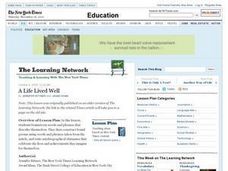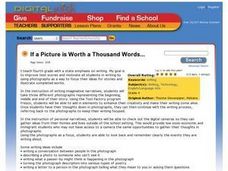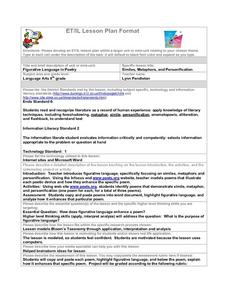Curated OER
Wish Boxes
I love these are lesson ideas! Young artists practice the art of Calligraphy and Origami. They make gift boxes with good wishes. This plan includes an excellent component that shows exactly how to fold the paper in order to make the box,...
Curated OER
Emotion Similes
Students define what a simile is before writing a poem that is based primarily on similes. They brainstorm and write the poem using the give format. They write drafts, revise and present a final poem.
Curated OER
Magical Creatures
Students investigate entertaining characters within stories. In this writing lesson, students review nouns and adjectives and discuss magical characters. Students ask themselves questions about their selected characters and write a...
Curated OER
Tell Me That You Love Me 5-7-5
Young scholars listen to several examples of Haiku poetry and discuss the strict format. Then students create and edit their own Haiku poems and enhance them with ink designs.
Curated OER
Book Report Haiku
Students study another method for writing a book report using a Haiku poem. In this book report lesson, students use the Haiku poem format to write a book report.
Curated OER
The Emperor and the Kite
Fourth graders explore storytelling by reading a classic story. In this vocabulary identification lesson, 4th graders read the story The Emperor and the Kite and define the different vocabulary terms that appear in the story. Students...
Curated OER
The Odyssey Lesson 6
"How are belief systems represented and reproduced through nature?" This essential question guides lesson 6 of this unit on The Odyssey (the rest of the unit is linked). Students first write about a scenario in which they are disguised,...
Curated OER
Biopoem: Bud, Not Buddy
Young poets focus on one character from a story they are reading, collect details, and use a biopoem template to analyze this character. The activity can be used with any text.
Houghton Mifflin Harcourt
Amazing Animals: English Language Development Lessons (Theme 4)
This packet, the second in the series of support materials for the Houghton Mifflin Harcourt thematic units on amazing animals, contains exercises and activities designed for the ESL/ELD classroom.
Curated OER
The Old Man and the Sea: Guided Imagery
What do you imagine when you think of the sea? Put on some ocean sounds, close your eyes, and listen to a guided meditation based on the imagery from The Old Man and the Sea by Ernest Hemingway. After class members listen to the...
Novelinks
Oedipus the King: Biopoem
The biopoem is a great way for instructors to get to know class members, classmates to get to know each other, and readers to flesh out their understanding of a character. Why not create a biopoem for a character from Oedipus the King?
Curated OER
Theology…the Use of Silence in the Classroom
Immerse your class in the Middle Ages with a thorough history lesson. After viewing examples of illuminated manuscripts such as the Book of Kells, they discuss how these were the mode of keeping and storing information employed by the...
Curated OER
The Outsiders Study Guide
Provide this packet for your pupils as they pour over The Outsiders by S.E. Hinton. The study guide includes graphic organziers and comprehension as well as higher-level questions. Class members briefly summarize each chapter, compare...
Curated OER
Flowers, Flowers, Flowers...A Visit with Georgia O'Keeffe
Students analyze, discuss, and research Georgia O'Keeffe and her flower paintings. They select a flower to paint and create a watercolor painting in the style of Georgia O'Keeffe. Students compose a poem describing their painting.
Curated OER
Awesome Saturn
Students brainstorm words that describe Saturn. They view images sent to Earth from satellites. They write poems about the planet using different poetic forms.
Curated OER
It's A Blue, Blue Monday
Learners create images that convey how the weather makes them feel. As a class, students discuss the way weather can effect their mood. After reading several passages describing the weather, learners use vivid descriptions and...
Curated OER
Eloquent Speech
Second graders discover that oral and written communication can be improved, and made to sound more eloquent, when the following questions are addressed; Who? What? Where? When? Why? students use word processing to copy a poem using clip...
Curated OER
A Life Lived Well
Students write poems based on words and phrases found in an obituatuary. They write autobiographical obituaries that imagine their own lives and future accomplishments.
Curated OER
Fall Similes
Students create descriptive autumn similes and write them on fall-themed paper. They first write the autumn simile, and then arrange the plants around the border of the paper. They use natural plants which must be pressed.
Curated OER
If a Picture is Worth a Thousand Words...
Fourth graders take three different photographs representing the beginning, middle and end of their story. They use the Tool Factor program Fresco to add elements to enhance their creativity and make their writing come alive. They then...
Curated OER
Similes, Metaphors, and Personification
Eighth graders explore figurative language, specifically focusing on similes, metaphors and personification. They work on the web to identify poems that demonstrate simile, metaphor, and personification, then analyze how it enhances...
Curated OER
Thanatopsis
In this poetry worksheet on "Thanatopsis," by William Cullen Bryant, students read the poem and answer several questions based on it. Students analyze word usage and tone, define 'elegy', and compare the poem to artwork created...
Curated OER
Life Size Characters
Sixth graders analyze character traits and create a life size character outline. In this character analysis lesson, 6th graders analyze character traits of a character using character webs and poems. Students then create a life size...
Curated OER
Getting to Know My Apple
First graders compare an apple to unlike things in a simile poem. ie: The apple tastes sour like a lemon. When poems are complete, have students share their simile poems with the class and finish eating their apples.

























